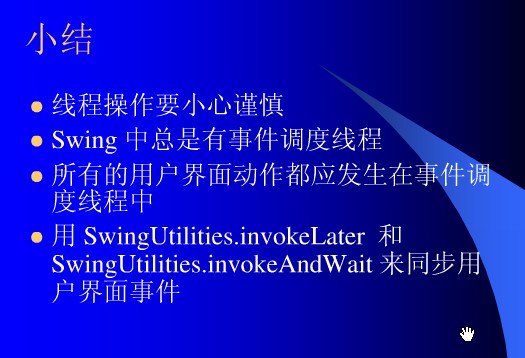62,628
社区成员
 发帖
发帖 与我相关
与我相关 我的任务
我的任务 分享
分享
private static void createAndShowGUI() {
//Create and set up the window.
JFrame frame = new JFrame("LayeredPaneDemo");
frame.setDefaultCloseOperation(JFrame.EXIT_ON_CLOSE);
//Create and set up the content pane.
JComponent newContentPane = new LayeredPaneDemo();
newContentPane.setOpaque(true); //content panes must be opaque
frame.setContentPane(newContentPane);
//Display the window.
frame.pack();
frame.setVisible(true);
}
public static void main(String[] args) {
//Schedule a job for the event-dispatching thread:
//creating and showing this application's GUI.
javax.swing.SwingUtilities.invokeLater(new Runnable() {
public void run() {
createAndShowGUI();
}
});
}
/**
* Posts a 1.1-style event to the <code>EventQueue</code>.
* If there is an existing event on the queue with the same ID
* and event source, the source <code>Component</code>'s
* <code>coalesceEvents</code> method will be called.
*
* @param theEvent an instance of <code>java.awt.AWTEvent</code>,
* or a subclass of it
*/
final void postEventPrivate(AWTEvent theEvent) {
theEvent.isPosted = true;
synchronized(this) {
if (dispatchThread == null && nextQueue == null) {
if (theEvent.getSource() == AWTAutoShutdown.getInstance()) {
return;
} else {
initDispatchThread();
}
}
if (nextQueue != null) {
// Forward event to top of EventQueue stack.
nextQueue.postEventPrivate(theEvent);
return;
}
postEvent(theEvent, getPriority(theEvent));
}
}
public class Tests {
public static void main(String[] args) throws Exception{
Runnable doHelloWorld = new Runnable() {
public void run() {
System.out.println("Hello World on " + Thread.currentThread());
try {
throwException();
} catch (Exception e) {
e.printStackTrace();
}
}
};
SwingUtilities.invokeLater(doHelloWorld);
System.out.println("This might well be displayed before the other message.");
JOptionPane.showMessageDialog(null, "DFDFDF");
}
protected static void throwException() throws Exception{
throw new Exception("Hello Exception");
}
}

